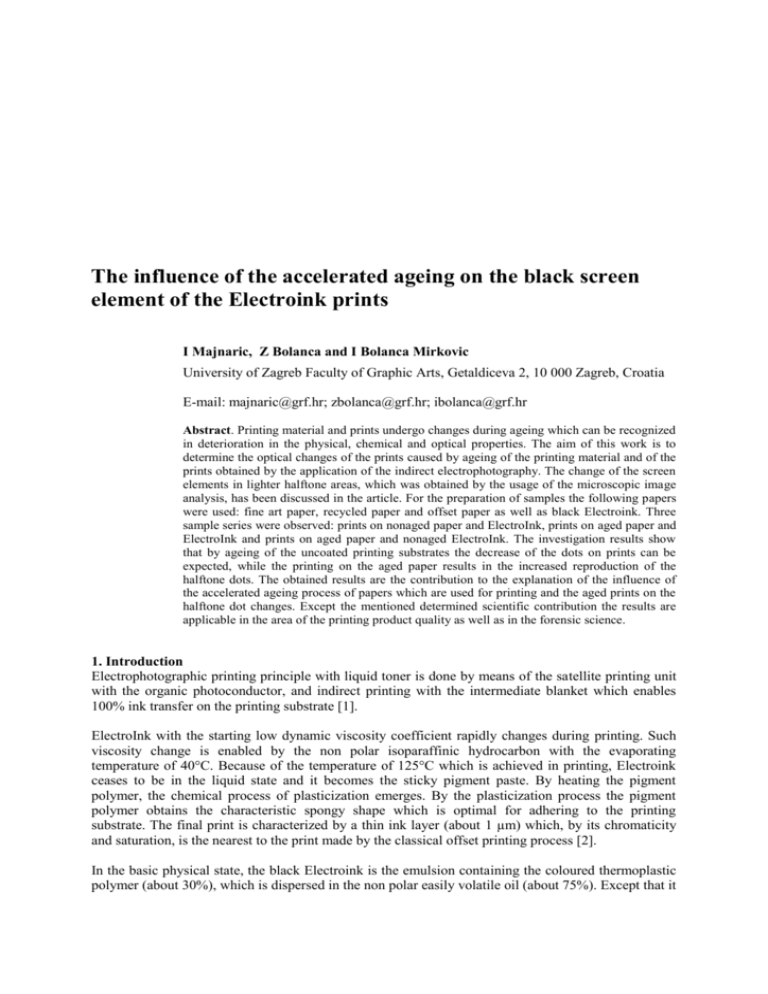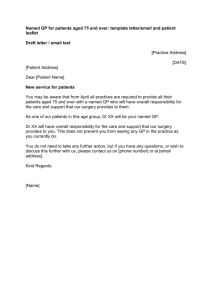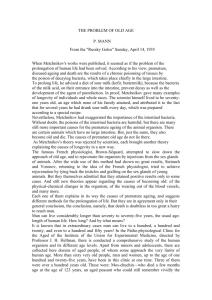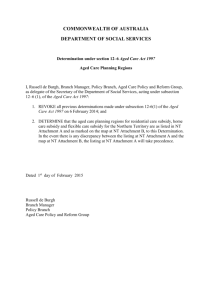Open Access proceedings Journal of Physics: Conference series
advertisement

The influence of the accelerated ageing on the black screen element of the Electroink prints I Majnaric, Z Bolanca and I Bolanca Mirkovic University of Zagreb Faculty of Graphic Arts, Getaldiceva 2, 10 000 Zagreb, Croatia E-mail: majnaric@grf.hr; zbolanca@grf.hr; ibolanca@grf.hr Abstract. Printing material and prints undergo changes during ageing which can be recognized in deterioration in the physical, chemical and optical properties. The aim of this work is to determine the optical changes of the prints caused by ageing of the printing material and of the prints obtained by the application of the indirect electrophotography. The change of the screen elements in lighter halftone areas, which was obtained by the usage of the microscopic image analysis, has been discussed in the article. For the preparation of samples the following papers were used: fine art paper, recycled paper and offset paper as well as black Electroink. Three sample series were observed: prints on nonaged paper and ElectroInk, prints on aged paper and ElectroInk and prints on aged paper and nonaged ElectroInk. The investigation results show that by ageing of the uncoated printing substrates the decrease of the dots on prints can be expected, while the printing on the aged paper results in the increased reproduction of the halftone dots. The obtained results are the contribution to the explanation of the influence of the accelerated ageing process of papers which are used for printing and the aged prints on the halftone dot changes. Except the mentioned determined scientific contribution the results are applicable in the area of the printing product quality as well as in the forensic science. 1. Introduction Electrophotographic printing principle with liquid toner is done by means of the satellite printing unit with the organic photoconductor, and indirect printing with the intermediate blanket which enables 100% ink transfer on the printing substrate [1]. ElectroInk with the starting low dynamic viscosity coefficient rapidly changes during printing. Such viscosity change is enabled by the non polar isoparaffinic hydrocarbon with the evaporating temperature of 40°C. Because of the temperature of 125°C which is achieved in printing, Electroink ceases to be in the liquid state and it becomes the sticky pigment paste. By heating the pigment polymer, the chemical process of plasticization emerges. By the plasticization process the pigment polymer obtains the characteristic spongy shape which is optimal for adhering to the printing substrate. The final print is characterized by a thin ink layer (about 1 µm) which, by its chromaticity and saturation, is the nearest to the print made by the classical offset printing process [2]. In the basic physical state, the black Electroink is the emulsion containing the coloured thermoplastic polymer (about 30%), which is dispersed in the non polar easily volatile oil (about 75%). Except that it contains the agents for increasing the electric conductivity - negative charge director (about 1%). In the thermoplastic polymer, the particles of the black pigment are built in, the share of which varies depending on chemical composition (pigment particles of the type Black 7 are contained from 10 to 35% while the ink carriers based on dye are contained from 3-25%). In the final phase, the ferromagnetic materials (such as iron, nickel and cobalt) can be added, the optimal share of which is 65%. The particle size of the black pigment is between 0,1 and 5 µm. The particles of the thermoplastic toner have a characteristic star like shape. Such shape serves primarily for better directing of the Electroink movement, i.e. for easier accepting the additives for the regulation of electric conductivity. They are explicitly polar molecules and catch the star like pigments with their more positive side. The caught pigment particles are now ready for directed movement toward the less negative electrostatic field [3]. The used black pigment based on carbon (CI Pigment Black 7) is one of the most important black ink carriers. Such pigments are extremely tiny particles, the inking density of which depends on the production method. Non rubber varieties, used in printing inks are produced in pallet, bead, dense or fluffy form. They are chemically inert, extremely fast to heat, light, acids, alkali, solvents and soap. However they do contain a small proportion of volatile material, the effect of which may become apparent on dispersion: accounts for over 95% black ink usage [4]. Generally speaking, the printing inks are the mixture of different components which are significantly dependent on the printing technology. The selection of suitable inks for printing and investigation of ageing stability of ink film are scarce. It is published in a study of stability for offset printing inks on alkaline paper upon damp heat and light ageing [5]. Their results indicate that black ink keeps the chemical and visual properties upon accelerated ageing, lower ageing stability especially for magenta and yellow prints. Halinova and coauthors studied changes in optical density, visible and FT-IR spectra and total colour differences of CMYK offset ink films printed on alkaline paper during accelerated ageing procedures with the aim to decide on the combination of paper vs. ink for permanent offset printing [6]. Deterioration in quality of an aged paper or prints can manifest itself in the physical mechanical, chemical and optical properties. In regard to the changes of paper over time, the term durability is interesting. Paper durability depends on the physical mechanical properties of raw materials used in paper production (fibers, sizing agent, additives, fillers) as well as on environmental elements such as microclimatic conditions (heat, humidity, light), pollutants present in the air (ozone, oxides of sulphur and nitrogen), traces of transition metal ions ( Fe (III), Cr(III), Cu(II)), biological agents (microorganisms, mould) and printing processes (composition and kinds of inks) [7-10]. The permanence of paper depends on the chemical resistance of its components and on the influence of external factors. Paper permanence includes such things as lightfastness and refers to the ability of printing inks to resist fading or changing of colour upon exposure to light or weather [11,12]. Discolouration of a paper may be caused by the formation of chromophores upon ageing as a result of exposure to other light and volatile gases. Many volatile compounds as well as alcohols, ketones, aldehydes, carboxylic acids aromatic and aliphatic hydrocarbons and ethers can be released from paper during degradation processes depending upon paper chemical compositions [13]. The investigation results of the screen dots change on the prints obtained by indirect electrophotography using the accelerated aged and non aged printing substrates for the reproduction in regard to the accelerated aged prints are presented in this work. The obtained results are the contribution to the explanation of the influence of the ageing process of the printing materials in the function of the reproduction characteristics in regard to the accelerated aged print. Except the mentioned contribution, the results are applicable in the area of the printing product quality as well as in forensic science. 2. Experimental For the production of samples the electrophotographic printing machine HP Indigo Series 1000 was used. The printing form contains the following elements: multi-colour halftone photographs, patches for the determination of the full tones inking density, patches for the determination of the halftone value, patches for the determination of the relative printing contrast, patches for the determination of trapping, millimeter scales for the determination of the dimensional stability of prints, marks for the register control, achromatic areas for the determination of the grey balance and the standard FOGRA PMS wedges. The uncoated natural paper, glossy fine art paper and the recycled paper were used as the printing substrates. Figure 1 Experimental flow For obtaining the measurable samples of different ages, paper and prints were aged in several phases: 1. phase: printing of non aged papers (2/3 of total printed run) 2. phase: accelerated ageing of the non printed papers (1/3 of samples) and ageing of 1/3 previously printed samples (made in the phase 1). 3. phase: printing of 1/3 of aged unprinted paper As it is visible from the presentation (figure 1), three real printing interactions were obtained: non aged paper – non aged ink, aged paper – aged ink and aged paper- non aged ink. The ageing of samples is in accordance with the standard ISO 5360 [14]. The following controlled conditions were used: air temperature of 80oC, relative humidity of 65% and the ageing period of 24 days, without the influence of radiation. The process of accelerated ageing was performed in the microclimatic chamber VUK 08/500 [15]. The diameters of the smallest achromatic printing elements (prints in the black halftone area from 10%, 20% and 30%) were analyzed with the equipment for image analysis (QUE Personal IAS). Before the performed image analysis the samples were stored in accordance with the TAPPI standard T 1219sp-98 [16]. The detailed densitometric analysis was done on a very small halftone dot. The relation of ageing and the quality of the screen reproduction is presented by measuring the optical reflectance from the surface with only one black printed screen element. 3. Results and discussion Diameter deviation of the halftone dots caused by the accelerated ageing for all three paper kinds (fine art paper, offset paper and the recycled paper) are presented in figure 2. The surfaces of 2,5 mm2 within the area of 10%, 20% and 30% tone value were analyzed. There is a general rule concerning the offset paper, that the aged prints form the smallest diameter of the screen elements, while the greatest halftone elements are obtained by printing on previously aged paper. One defective printing within the 20% halftone area (the smallest size of the printing elements was achieved for the non aged print) is noticed. On the non-aged print on offset paper, in the area of 10% halftone value (160 elements) the average size of the screen elements d10%= 44,77 µm is noticed. With the ageing process, the screen elements in the same area are decreased from d=-14,05 µm, while the print on the aged offset paper gives the increase from d=0,18 µm. For the area of 20% halftone value the non aged printed elements (245 elements) have the average diameter of d20%= 63,69 µm. The standard deviation within the printed elements is very big SD=31,77 µm. With the ageing itself the halftone elements increase for d =1,54 µm, while the printing on the aged paper gives the increase of d=15,47 µm. In the darkest investigated area (30%RTV-a) the non aged printed elements (224 elements) give the smallest average diameter d30%= 98,02 µm. With the accelerated ageing the decrease of the screen elements of d =-11,89 µm is achieved, while the printing on an aged paper gives the increase of d =7,44 µm. Figure 2 Diameter deviations of the halftone dots caused by the accelerated ageing Prints made of the recycled paper are characterized by the regular change of the printed elements in relation to the halftone value. The increase of the halftone value for 10% results in the increase of the screen elements for approximately dmed=30,00 µm. On non aged print made on the recycled paper, in the area of 10% halftone value (177 elements) the average screen element size of d 10%= 45,69 µm is noticed. The ageing process causes the decrease of the screen elements in the same area of d=-18,12 µm, while the print on aged offset paper gives the increase of d=6,11 µm. In the area with 20% halftone value the non aged printed elements (245 elements) give the average diameter of d 20%= 72,04 µm. The standard deviation within the printed elements is great SD=31,77 µm. With the ageing itself, the screen elements decrease for d =-4,1 µm, while the printing on aged paper gives an increase of d=6,66 µm. In the area with 30% halftone value, the non aged printed elements (210 elements) give the smallest average diameter d30%= 105,5 µm. With the accelerated ageing the decrease of the halftone elements of d =-8,89 µm is realized while the printing on aged paper ensures the decrease of d =1,59 µm. The process of accelerated ageing (the aged print and the print on aged fine art paper) gives the greatest oscillations within the printed halftone elements. In this case the smallest halftone elements are formed. On the non aged print made on fine art paper (gloss), in the area of 10% halftone value (177 elements) the average halftone size of d10%= 36,41 µm is noticed. In the ageing process the halftone elements in the same area increase for d= 2,79 µm, while the print made on aged offset paper gives the increase of d=14,23 µm. In the area with 20% halftone value the non aged printed elements (219 elements) give the average diameter of d20%= 68,43 µm. The standard deviation within the printed elements is great SD=25,2 µm. With the ageing itself, the screen elements increase for d =-4,19 µm, while the printing on the aged paper gives an increase of d=15,47 µm. In the area with 30% halftone value, the non aged printed elements (217) give the smallest average diameter d30%= 93,67 µm. With the accelerated ageing the decrease of the halftone elements of d =-3,4 µm is realized while the printing on aged paper ensures the increase of d =-19,89 µm. On the non aged printed papers the standard deviation of the black halftone dots is SDoff=31,77µm, SDrec=33,54 µm, SDgloss=25,2 µm. With the accelerated ageing the deviation of the halftone dots is decreased (SDoff=22,36 µm, SDrec=19,42 µm). The exception is the fine art paper, SDgloss=28,68 µm. With the printing on the aged paper the results with the same tendency are achieved, i.e. the decreased deviation of the screen elements as with the aged print (SDoff=25,44 µm, SDrec=24,27 µm, SDgloss=33,94 µm). The analysis of only one halftone dot (the characteristic dot in the area of 20% halftone value) is presented in figures 3,4,5. The densitometric reflectance (R%) on different aged prints is also presented. It is generally valid for all the presented curves that great reflectance from the reproduced dot gives the contrast picture and greater darkness. Figure 3 Reflectance from the surface of one black halftone dot on differently aged prints made on offset paper With the image analysis (threshold 60%) of the surface from three halftone dots (selected area in the lower left angle) the following diameters are obtained: d=90,06 µm (non aged printed dot), d= 76,29 µm (accelerated aged dot), d=87,81 µm (non aged dot on the aged paper).The reproduced halftone element which best matches the ideal Gauss’s curve is the aged offset print. Great steepness and the small reflectance with the maximum of R= 32,036% is characteristic for this curve. It is the direct consequence of ageing of the black pigment and the offset printing substrate. The other two curves are not so steep, which means that the dots have somewhat greater halo. The new printed halftone dot has the greatest reflectance (R=22,911 %), while the layer of the black Electroink on aged paper gives somewhat smaller reflectance (R=24,223%). Printing on the aged paper gives much broader peak inking density which can be attributed to the physical chemical ageing process of the non coated printing substrate. Figure 4 Reflectance from the surface of one black halftone dot on differently aged prints made on the recycled paper With the image analysis of the printed recycled printing substrate (identical position) the following diameters are obtained: d=80,24 µm (non aged printed dot), d= 64,11 µm (accelerated aged dot), d=87,19 µm (non aged printed dot on aged paper).The least steep reflectance curve is obtained from the halftone dot surface which was printed after the accelerated ageing of the recycled paper. This resulted with great screen halo which is the direct result of the accelerated ageing of the printing substrate, which is visible yellow (R=35,497%). The non aged printed halftone dot has also high reflectance (R=35,221 %), which is held on greater part of the central dot (halo is not great). The reproduced halftone element which matches the ideal Gauss’s curve least of all is the aged print made on the recycled paper. High steepness and two peaks with the maximal reflectance R=37,778% and R=41,133% are characteristic for that curve. With it, the worst reproduction of the black halftone element is achieved. Figure 5 Reflectance from the surface of one black halftone dot on differently aged prints made on fine art paper With the image analysis of the fine art paper of high quality, the following diameters are obtained: d=55,12 µm (non aged printed dot), d= 79,56 µm (accelerated aged dot), d=113,51µm (non aged printed dot on aged paper). In relation to the other analyzed printing substrates, it is characteristic, that the analyzed area on the non aged fine art paper has not got great reflectance (R max=39,624%). Accelerated ageing influences the physical chemical change of the paper coating itself which influences the darkening of prints. The reproduced halftone element which best follows the ideal Gauss’s curve is the one which is submitted to the accelerated ageing. In this connection the maximal reflectance R max= 17,778 % is achieved. Printing on the aged paper gives a very big halftone element in which the broad halo dominates (the central reflectance is Rmax= 19,426%). It can be expected that with the ageing of the black Electroink itself the minimal changes in reflectance of R=1,647% appear. 5. Conclusion The investigation results show that the ageing of the non coated printing substrates causes the decrease of the printed halftone dots. Printing on the aged paper results in the increased reproduction of the screen elements (especially in darker tones, 30% halftone value). For ROS Indigo electrophotographic laser head the generating of the screen elements with different sizes is characteristic. Their deviation (20% halftone value) depends on the type of the printing substrate and on the way of ageing. In the combination, the non aged paper with the aged ink / aged paper with the non aged ink lead to the decrease of the standard deviation on natural papers (SDoff=-9,41, SDrec=-14,42µm), while the standard deviation (SDgloss=3,48 µm) increase on fine art paper. In the combination aged paper and aged ink/ aged paper and the non aged ink, on all the printing substrates, the standard deviation increases (SDoff=3,08µm, SDrec=4,85 µm, SDgloss=5,26 µm).The non aged print on the non aged paper results in highest reflectance from the center of the printed screen dot. In relation to the non aged print on offset paper, the ageing of the screen dot creates the maximal difference in reflectance R= 9,125%, while in relation to the print made on aged paper the maximal difference in reflectance appears R=1,312%. In relation to the non aged print on the recycled paper, the ageing of prints creates the difference in reflectance R= 2,557%, while in the relation to the print made on aged paper the difference in reflectance is insignificant R=0,276%. Acting of the accelerated ageing influences mostly the print on the recycled paper creating an uneven reflectance from the surface of the printed screen element. Because of its coating (gloss), the fine art paper behaves differently from the uncoated papers. The accelerated ageing of fine art paper gives greater and darker screen elements. In relation to the print made on the non aged paper, the ageing of the screen dot causes the increase R=21,843%, while the printing on the aged fine art paper causes further increase of R=20,195%. The research results are very useful for explanation of the ageing mechanism of material and prints in digital printing in the function of evaluation of the durable materials and materials of new formulation. References [1] Majnaric I Bolanca I Bolanca Z and Milkovic M 2005 Condition in digital printing of packaging on the print quality Proc. International Conference on Digital Production Printing and Industrial Applications (Amsterdam, Netherlands, 9-13 May 2005) ed R Borrell (IS&T vol 3) pp 97-99 [2] Majnaric I Bolanca S and Golubovic K 2007 The influence of ElectroInk pigmentation on the quality of indirect digital printing, Proc. of 11th International Conference on Printing, Design and Graphic Communication (Zadar, Croatia, 26-29 September 2007) ed Z Bolanca (Zagreb: Faculty of Graphic Arts) pp 85-89 [3] Landa Bet 1988 Toner for use in composition for developing latent electrostatic images, method of making the same and liquid composition using improved toner, Patent United States 4,794,651, 27 [4] Leach R and Pierce R 1999 The Printing Ink Manual,(Dordrecht: Kluwer Academic Publishers, Netherlands) [5] Maraval M and Flieder F 1993 The stability of printing inks Restaurator 141 41-171 [6] Halinova B Babiakova D Brezova V Durovic M Novotna M and Belanyi F 2002 The stability of offset inks on paper upon ageing Dyes and Pigments 54 173-188 [7] Bonham J S and Rolniczak B 2006 Accelerated ageing of copy papers containing recycled fibre Appita 59 365-369 [8] El-Sakhawy M 2005 Effect of bleaching sequence on paper ageing Polymer Degradation and Stability 87 419-423 [9] Johansson A and Lennholm H 2000 Influences of SO2 ,NO2 and O3 on the ageing of paper investigated by in situ diffuse reflectance FTIR and time-resolved trace gas analysis Applied Surface Science 161 163-169 [10] Johansson A 2000 Air pollution and paper deterioration, causes and remedies Dissertation Göteborg University Sweden [11] Fjellstrӧm H Hӧbglund H and Paulsson M 2007 Light-inducet yellowing of mecanical and chemimechanical pulp sheets-Influence of wood raw material, process and aging method Nordic Pulp and Paper Research 22 117-123 [12] Mcgarry P F Schmidt J A and Heitner C 2004 Accelerated light exposure of wood-containing pulps. Part I: Effects of wavelength and intensity Tappi Journal 3 18-24 [13] Carter H P Begin D and Grattan 2000 Migration of volatile compounds through stacked sheet of paper during acclerated ageing Restaurator 21 77-84 [14] ISO 5360:2006 Anaesthetic vaporizers-Agent-specific filling systems [15] TAPPI T 1219sp-98, Storage of Paper Samples for Optical Measurements and Colour Matching







